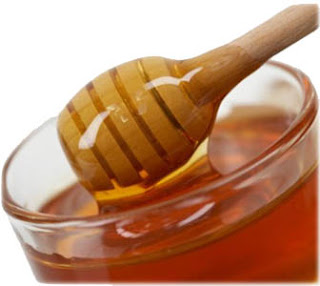
Honey (/ hʌni /) is a sweet food made by bees from flower nectar. The variety produced by honey bees (genus Apis) is the most commonly referenced. It is the type of honey collected by beekeepers and consumed by humans. The honey produced by bees and insects has very different properties.
Honey bees transform nectar into honey by a process of regurgitation and evaporation. They save it as a primary food source in wax honeycombs inside the beehive. Honey gets its sweetness of the monosaccharides, glucose and fructose, and has approximately the same sweetness as sugar relative granulate. It has attractive chemical properties for baking, and a distinctive flavor which leads some people to prefer it over sugar and other sweeteners. Most microorganisms do not grow in honey due to its low water activity of 0.6. However, honey sometimes contains dormant endospores of the bacterium Clostridium botulinum, which can be dangerous for children, as the endospores can transform into toxin-producing bacteria in the infant's immature intestinal tract, leading to illness and death.
Nutritional value per 100 g (3.5 oz)
 |
Carbohydrates: 82.4 g
- Sugars: 82.12 g
- Dietary fiber: 0.2 g
Fat: 0 g
Protein: 0.3 g
Water: 17.10 g
Riboflavin (vit. B2): 0.038 mg (3%)
Niacin (vit. B3): 0.121 mg (1%)
Pantothenic acid (B5): 0.068 mg (1%)
Vitamin B6: 0.024 mg (2%)
Folate (vit. B9): 2 μg (1%)
Vitamin C: 0.5: mg (1%)
Calcium: 6 mg (1%)
Iron: 0.42 mg (3%)
Magnesium: 2 mg (1%)
Phosphorus: 4 mg (1%)
Potassium: 52 mg (1%)
Sodium: 4 mg (0%)
Zinc: 0.22 mg (2%)
Shown is for 100 g, roughly 5 tbsp.
Percentages are relative to
US recommendations for adults.
Typical honey analysis:
Fructose: 38.2%
Maltose: 7.1%
Sucrose: 1.3%
Water: 17.2%
Higher sugars: 1.5%
Ash: 0.2%
Other/undetermined: 3.2%
 |
 |
 |
 |
 |








0 Comments